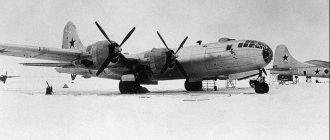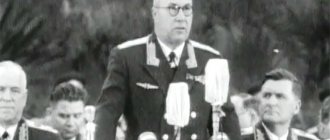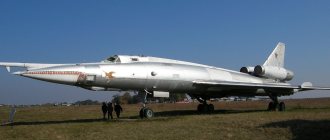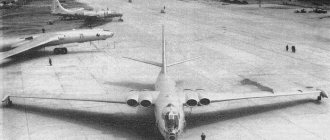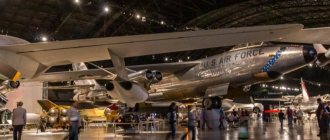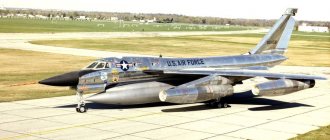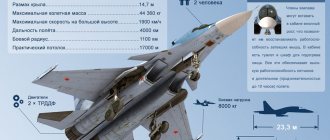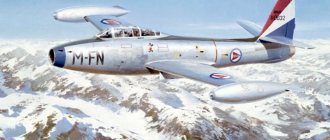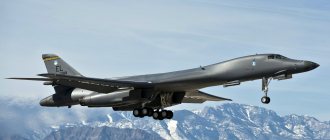Bomber Convair B-36 "Peacemaker"
The Convair B-36 was originally intended to be a true superbomber. This is an American intercontinental bomber that has forever taken its place in history. Firstly, this bomber became the world's first intercontinental carrier of nuclear weapons. It was with the Convair B-36 bomber that the concept of a global nuclear war entered our lives, and gradually the understanding began to penetrate into the minds of world politicians that in such a war there simply could not be a winner. Perhaps that is why this bomber received its unofficial nickname “Peacemaker” (“Peacemaker”). Secondly, this machine became one of the largest ever built among all combat aircraft: the largest wingspan and height. At the time of its creation, this aircraft was second in size only to the famous Hercules flying boat, created by Howard Hughes. The B-36 became the world's first bomber that could fly intercontinentally. This interesting aircraft was designed and produced by Convair in response to the technical requirements of the US Army Air Corps, which were prepared on April 11, 1941. The military demanded the creation of a combat aircraft that would have a maximum bomb load of 32,659 kg. This aircraft was supposed to, starting from air bases located in the United States, deliver 4536 kg of bomb load to targets in Europe.
The main requirement of the military was the flight range without refueling, which should have been at least 16,093 km; in addition, it was necessary to ensure a flight speed in the range of 386-483 km/h and a service ceiling of at least 10,670 meters. Of the four proposed aircraft designs, the US military chose the Model 36, which featured a pressurized fuselage and a 1.83-meter thick wing root, which provided access during flight to the power plant, which consisted of 6 piston engines with pusher propellers. The design initially called for a twin-fin tail, but by the time the XB-36 prototype was fully assembled and ready to roll out of the Fort Worth workshop (September 8, 1945), the bomber already had a single-fin tail.
The prototype XB-36 bomber took to the skies on August 8, 1946, the vehicle featured single-wheeled main landing gear bogies. The second aircraft, designated YB-36, also intended for testing, initially had single-wheeled bogies, but they were later replaced by four-wheeled ones, which became standard on production bombers. The modernized version of the aircraft received the designation YB-36A; it differed from the XB-36 in the external shape of the cockpit canopy, which protruded beyond the contours of the aircraft fuselage, engines on which modified turbochargers were installed, and also in the fact that technological connectors, and a radar was installed.
Back on July 23, 1943, Convair received a government order for 100 bombers, but only 4 years later, on August 28, 1947, the first of 22 production B-36A aircraft in an unarmed version of a training aircraft designed for crew training was able to make its first flight. Serial production of the B-36 bomber, nicknamed Peacemaker, lasted almost 7 years. The last aircraft built was transferred to the US Air Force Strategic Air Command on August 14, 1954, and on February 12, 1959, the last such intercontinental bomber was withdrawn from service.
When creating the aircraft, the greatest attention was paid to achieving intercontinental flight range. The designers were well aware that the flight range was proportional to the aerodynamic quality of the bomber, the relative mass of its fuel and inversely proportional to its specific consumption. In order to maximize the aerodynamic quality in the project of the future B-36 Peacemaker strategic bomber, it was decided to use a high aspect ratio wing with laminar profiles. To reduce the level of drag, it was decided to install the engines inside the wing and use pusher propellers. The smooth surface of the bomber's fuselage was also not disturbed by any protruding parts; the cockpit was fitted into its contour, and it was decided to make all defensive installations with twin automatic 20-mm cannons retractable. According to the manufacturer's information, the aerodynamic quality of the bomber reached 21 units, which was significantly higher than that of all bombers of those years. For example, the best American bomber of World War II, the Boeing B-29, had a rating of 19.1.
To improve the weight perfection of the bomber, the most modern at that time high-strength aluminum alloys 75ST were widely used in its design, and AN-M-29 magnesium alloys were used in less critical components. Among other things, approximately half of the fuselage skin was made of magnesium alloy, for this reason one of the unofficial nicknames of the future B-36 bomber was the “Magnesium Monster.” The total mass of magnesium parts was up to 10% of the total mass of the aircraft airframe. At the same time, the entire fuel supply was located in the wing tank compartments. The bomber's wing, whose deflection under load reached two meters, was calculated by the designers as a dynamically elastic structure, which was an innovation at that time.
In addition to the intercontinental flight range, another rather difficult requirement for the US military to meet was a huge bomb load. When the technical requirements for the bomber were just being developed, there was still more than one year left before the start of the now famous Manhattan Project, and increasing the striking power of the aircraft so that it was able to solve strategic problems was only possible due to the ability to take on board a large number of ordinary bombs. In order to accommodate the specified 32,660 kg of bombs, the designers had to design a bomb bay more than 20 meters long and about 3 meters in diameter. This bomb bay determined other dimensions of the aircraft, in particular its famous wingspan of 70 meters.
The sufficiently long bomb bay forced the expansion of the range of acceptable alignments. For this purpose, the aircraft's wing was given a slight sweep. At the same time, the total volume of the bomb bay, which was conventionally divided into 4 sections, amounted to 68% of the total volume of the bomber fuselage. Very large cutouts for bomb bays forced the designers to partially abandon the semi-monocoque fuselage design that was generally accepted in those years. The middle part of the fuselage, located between two pressurized cabins, was a truss structure with a light magnesium lining. The large dimensions of the aircraft and, consequently, the very large take-off weight, exceeding 140 tons, required the designers to use 6 of the most powerful engines at that time - 28-cylinder four-row Pratt & Whitney R-4360-25 air-cooled. At the same time, it was possible to design a boosterless control system for the giant bomber, which was a unique achievement of American aircraft designers.
Serial production of Convair B-36 bombers continued until August 14, 1954 and significantly exceeded the initial order for 100 aircraft. A total of 383 bombers of various types were manufactured. At the same time, bombers of all modifications, starting with the Convair B-36D model, were equipped with 4 additional General Electric J47-GE-19 jet engines, each with a thrust of 2720 kgf. As a result, the B-36 bomber holds the unsurpassed record of being the aircraft powered by 10 engines of two fundamentally different types.
At the same time, it was decided to use jet engines only at two stages of the flight - during takeoff and climb, as well as for acceleration and additional climb directly above the target. The rest of the time, which was most of the entire flight, these engines remained turned off. In this regard, the designers had to modify the anti-icing system by connecting the heating of the engines and pylon to the general aircraft system, otherwise the engines could simply become covered with ice. In addition, the nose cones of the turbojet engines received special electrically driven flaps, which, in the open position, blocked the inlet channel when the engines were turned off. This solution improved the aerodynamics of the aircraft during flight at cruising speed.
Initially, Convair B-36 bombers were intended exclusively for “carpet” bombing using conventional high-explosive and incendiary bombs. For this purpose, the aircraft received a huge bomb bay, conventionally divided into parts. Two compartments were located in front of the wing, and two more behind it. In addition, special racks with locks were installed on the main fuselage trusses, on which, if necessary, different models of bomb racks could be mounted. At the top of the bomb bay there were power jumpers, which made it possible to secure blocks and hoists for hanging heavy ammunition.
The range of weapons used was very diverse; it included 67 types of different high-explosive, chemical and nuclear bombs and even several types of seaborne aircraft mines. Convair B-36 bombers could carry the entire arsenal of atomic and hydrogen bombs of that time period. We are talking about first generation nuclear weapons; the weight of such bombs did not exceed 5 tons. It was with this bomb load that the aircraft could achieve its intercontinental flight range, maximum speed and maximum ceiling, which are indicated in numerous reference books. With a maximum load of 32,600 kg, the flight range was significantly reduced. With such a bomb load, the plane could not reach the territory of the Soviet Union. At the same time, using jump airfields located in Alaska, Great Britain, Greenland or Guam, the Convair B-36 bomber could deliver a fairly heavy load to the USSR.
With the advent of serial B-52 models into service with the US Air Force by the end of the 1950s, the obsolescence of the B-36 aircraft became obvious, and almost all of the aircraft were soon scrapped. This was facilitated by the relatively low reliability and labor intensity of servicing piston engines in comparison with gas turbine engines. The B-36's power plant, consisting of 6 propeller engines and 4 jet engines, was nicknamed "six spinning, four burning." Due to frequent fires and general unreliability, at the suggestion of bomber crews, this formula was changed to the following: “two are spinning, two are burning, two are smoking, two are making fun of them, and two more have disappeared somewhere.”
B-36 aircraft never took part in real combat operations, but were widely used as reconnaissance aircraft (modification of the RB-36). The huge size of the bomber made it possible to install high-resolution cameras on it, and the high flight altitude made the aircraft inaccessible to fighters and anti-aircraft artillery of those years. It is assumed that in the early 1950s, the RB-36 made at least several reconnaissance flights over the territory of the USSR and China. In addition, the machine was used in a number of experiments. For example, a specially converted bomber, designated NB-36H, flew with a nuclear reactor on board as part of the nuclear aircraft development program. The purpose of this experiment was to study the effect of radiation on aircraft systems and its crew. At the same time, in the end, work on the development of aircraft with a nuclear power plant did not develop.
And although the B-36 bomber was never used for its intended purpose, it managed to carry out a “bombing mission” that almost ended in disaster. It is worth noting that such episodes were not uncommon in the United States. Since the 1950s, there have been 32 strategic nuclear weapons accidents there, 5 of which could have resulted in a real nuclear explosion. The B-36 bomber took part in one of these episodes on May 22, 1957. The plane was transporting a thermonuclear bomb from Biggs Air Force Base to Kirtland Air Force Base in New Mexico. When approaching the final point of its route, the bomb, the type of which was not named, simply fell out of the plane. The ammunition landed 7 kilometers from the control tower at Kirtland Air Force Base and just 500 meters from the Sandia nuclear weapons depot. As a result of the fall, a conventional bomb explosive detonated, which under normal conditions initiates the detonation process of the plutonium core. There was no nuclear explosion then, but a crater with a diameter of 7.6 meters and a depth of 3.7 meters was formed at the site where the strategic ammunition fell.
Flight characteristics of the Convair B-36 J-III: Overall dimensions: length - 49.4 m, height - 14.25 m, wingspan - 70.1 m, wing area - 443.3 m2. The empty weight of the aircraft is 77,580 kg. Curb weight - 120,700 kg. Maximum take-off weight - 190,000 kg. Power plant - 6 Pratt & Whitney piston engines with a power of 3800 hp each. every. Additionally, 4 General Electric turbojet engines with a power of 23 kN each were installed. Maximum flight speed is 685 km/h (turbojet engines included). Cruising flight speed is 380 km/h (turbojet engines are turned off). Flight range - 11,000 km with a payload of 4535 kg. Ferry flight range is 16,000 km. Service ceiling - 15,000 m. Cannon armament - 16x20 mm M24A1 automatic cannons. Bomb load - up to 39,010 kg. Crew - 9 people.
Blog photos ru-aviation.livejournal.com
Sources of information: https://www.airwar.ru/enc/bomber/b36.html https://aviadejavu.ru/Site/Crafts/Craft21032.htm https://www.dogswar.ru/voennaia-aviaciia/samolety /4610-strategicheskii-bomb.html https://avia.pro/blog/convair-consolidated-b-36 https://ru-aviation.livejournal.com/3379685.html
The history of the creation of the Curtis P-36 "Hawk" fighter
By the mid-1930s, the main fighter of the US Air Force was the already quite outdated Boeing P-26 Peashooter . The war was approaching, everyone could see it, so the question arose about replacing the P-26 with a modern combat vehicle. During the announced competition, only one completed the given deadline, just a few days ahead of its nearest competitor. The development of the Curtis company was called simply - “Model 75B” and showed the same simple characteristics.
The competition was extended, however, by the new deadline, neither the Model 75B nor the SEV-1XP designed by Seversky, completed by this time, impressed the commission with the results. The deadlines were pushed back again, and on April 15, 1936, 4 aircraft were presented to the commission for consideration: Model 75B, SEV-1XP, Model V-141 (Consolidated company).
Seversky's fighter won and went into production under the name P-35 (order for 77 aircraft), however, Curtis, who took second place, was ordered a small batch - only 4 aircraft, for further testing. This aircraft went down in history as Y1P-36 .
Military pilots liked the Y1P-36 - it was light and easy to fly, stable in flight and quite maneuverable fighter. According to their reviews, on July 7, 1937, Curtis received a contract from the command of the US Air Corps to build a series of 210 aircraft, which was now called the P-36A. The success was stunning - the United States had not had such a large order for military aircraft since the end of the First World War. Despite all the design flaws (and initially there were quite a few of them), Curtis could celebrate victory.
The life of its P-36 was relatively short - for only 2 years this fighter was “on horseback”, and then at one moment it was “washed away” by a wave of new powerful machines coming one after another - P-38 Lightning, P-40 Tomahawk ", R-39 "Airacobra". Already by the time of Japan's attack on Pearl Harbor in 1941, P-36 Hawks were found mainly as training vehicles, or in remote garrisons. And yet, it was the P-36 that was the first of the American fighters to experience the hardships of war, and simultaneously on all its fronts - from air battles over France, through battles in Southeast Asia, to Alaska itself.
Production of the P-36 ceased in July 1942, during which time 1,300 fighters of all modifications were produced.
P-36 Hawk drawing
References
- Knaak 1988, p. 34.
- Convair proposed the name "Peacemaker" in a competition to name the bomber. Although the name "Peacemaker" has not been officially adopted, it is widely used and sources often state or imply that the name is "official". Peacekeeper Name Certificate, 7th Bomb Wing B-36 Association
- "Video: The Largest Bomber, August 15, 1946." Universal Newsreel, 1946. Retrieved February 20, 2012.
- Taylor 1969, p. 465.
- Griswold, Wesley P. "Remember the B-36." Popular Science
, September 1961. Retrieved May 15, 2010. - "Weapons of Mass Destruction (WMD): B-36 Peacemaker." globalsecurity.org. Retrieved: September 5, 2009
- Leach 2008, p. 29.
- Jenne 2004, pp. 136–137.
- Boger, Joe. "Convair NB-36N". US Air Force Bombers: Convair B-36 Peacemaker: joebaugher.com, September 19, 2000 Date accessed: May 14, 2010 Quote: "
- "Lieutenant General James Edmundson on: Flying the B-36 and B-47." The American Experience
, PBS, January 1999. Accessed May 15, 2010. - Jacobson and Meyer, The Big Stick
. - Knaak 1988, p. 53.
- "Convair YB-36 "Peacemaker"". Archived July 18, 2011, at the Wayback Machine. AeroWeb. Retrieved: May 15, 2010
- Convair YB-36G (YB-60) "Peacemaker". Archived July 18, 2011, at the Wayback Machine. AeroWeb
. Retrieved: May 15, 2010 - "B-36 Deployment". strategic-air-command.com. Retrieved: June 14, 2010
- ↑ a b
Knaack 1988, pp. 54–55.
Related aircraft
Related developments
- McDonnell XF-85 Goblin
- Convair YB-60
- Convair XC-99
- Convair Model 37
Similar aircraft
- Boeing XB-55
- Nakajima G10N
- Tupolev Tu-95
Notation sequences
- Number
sequence (internal for Consolidated): ← — — —
36
— — — - Secuencia B-_
(Bombarderos del USAAC/USAAF/USAF, 1926-1962): ← XB-33 - B-34 - YB-35 - B-36 -
B-
37 - XB-38 - XB-39 →
Modifications of the Curtis P-36 "Hawk" fighter
Y1P-36 - "Model 75", prototype, with an R-1830 "Twin Wasp" engine producing 950 hp.
R-36A is the first production model of a fighter with 1x12.7 mm and 1x 7.62 mm machine guns and a Twin Wasp R-1830-13 engine with a power of 1050 hp. As soon as he began to enlist in the troops, he was harshly criticized by the pilots, to the point of completely refusing to fly obviously unfinished aircraft. Subsequently, all produced R-36As were upgraded to R-36C.
Hawk.75A-1 (pre-war order) - export version of the P-36A for France, with an R-1830-SC-G engine with a power of 950 hp, 4x 7.5 mm Browning machine guns and instrumentation calibrated in metric system.
Hawk.75A-2 (pre-war order) - export version of the P-36 for France, with an R-1830-SC3-G engine with a power of 1200 hp, 6x 7.5 mm Browning machine guns and instrumentation calibrated in metric system.
Hawk.75A-3 (military order) - export version of the P-36 for France, with an R-1830-S1C3-G engine with a power of 1050 hp, 6x 7.5 mm Browning machine guns (or Colt - optional) and instrumentation calibrated in the metric system.
Hawk.75A-4 (military order) - export version of the P-36 for France, with a Wright-Cyclone GR-1820-G205A engine with a power of 1200 hp, 6x 7.5-mm Browning machine guns (or " Colt" - optional) and instrumentation calibrated in the metric system. The speed of this model was 520 km/h.
Hawk.75A-5 (Mohawk IV) - A copy of the A-4 for China, which was eventually produced in India and served with the RAF. Less than 10 cars produced.
Hawk.75A-6 - export to Norway, with an R-1830-S1C3-G engine (1200 hp) and 4x 7.9 mm machine guns. Several of these eventually entered the RAF under the designation Mohawk III. 8 cars went to Finland.
R-36G (Hawk.75A-8) - exported to Norway, a copy of the A-6, but with 2x 12.7 mm synchronized machine guns. Due to the occupation of Norway, all 36 aircraft were sent to Canada, then 30 were returned to the United States, which after the war transferred 28 of them to Peru, where they served until 1954.
survivors
Four B-36s
, one
B-36H
and three other
B-36Js
.
B- 36H
serial number
51-13730
is on display at the Castle AFB Museum.
Of the three B-36Js,
serial number
52-2217
is on display at the SAC Museum between Omaha and Lincoln, Nebraska (formerly at Offutt AFB),
52-2220
is on display at
the WPAFB Museum
, and serial number
52-2827
B-36
built , is on display in his hometown of Fort Worth, Texas.. It is unlikely that either of them will fly again;
It was not easy to keep the B-36 in the air
, even when it was new.
Notes
- Built in a single copy, the Hughes H-4 Hercules seaplane was a transport vehicle
- Knaack, Marcelle Size. Post-World War II Bombers, 1945-1973
. Washington, DC: Office of Air Force History, 1988. ISBN 0-16-002260-6. - [www.nationalmuseum.af.mil/factsheets/factsheet.asp?id=2584 “Convair XB-36 Factsheet”] National Museum of the USAF
- Daciek, Michael R. “Speaking at random about flying and writing: B-36 Peacemaker/Ten Engine Bomber” // YourHub.com, 13 December 2006. Retrieved: 6 April 2009.
- Gordon, Rigmant, 2002, p. 110.

